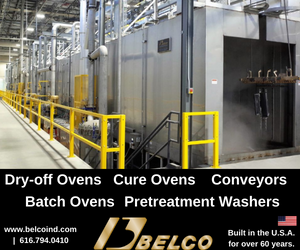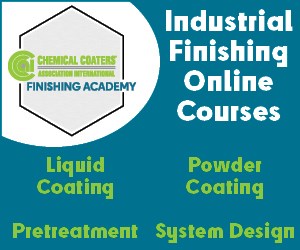Powder Coating Automation Can Reach ESG Goals for Automotive Parts
By adopting the robotic process automation (RPA) powder applicator, a plant can make significant savings for both the environment and the bottom line.

Q: Our company is working to strengthen our corporate environmental, social and governance (ESG) goals. I have been asked to identify opportunities within our process. Is there anything new for the automotive industry that can help improve our ESG, primarily focusing on our primer line?
A: A few new processes can impact your material consumption. Powder is an alternative to improve material consumption because powder can be reclaimed, unlike liquid material.
Some automotive plants use robotic process automation (RPA), a quick-disconnect robot-mounted powder applicator, primarily to apply powder prime. The applicator has no moving parts, so its maintenance cost is minimal. The bell-like pattern enables wide, flexible pattern size and can provide bell or gun-like patterns, meaning it can be used on both broad areas and cut-in areas. With minimal impact fusion, the applicator can reduce gun spits. The gentle powder handling permits better powder with fewer issues, while providing superior film build uniformity and improved patterns.
By adopting the RPA powder applicator, a plant can make significant savings for both the environment and the bottom line. With its increased flow rates of up to 800 g/min, an application will require fewer robots or machines, leading to lower capital costs and reduced operating expenses. The applicator's lack of moving parts also contributes to additional savings.
While the RPA powder applicator offers increased flow rates, it requires a dense-phase powder delivery system to meet its demand. However, this system also brings numerous benefits, including no powder damage, implicit closed-loop mass flow control, smooth powder flow (zero pulsation), and ± 2-gram repeatability, ensuring precise and efficient powder application.
While this type of powder system may not be suitable for every application, it offers numerous benefits, particularly when considering new processes to align with your company’s ESG goals. The potential environmental impact of this choice can inspire a positive change in your operations, making it a compelling option to consider.
About the Author

Nicolas Gervaise
Nicolas Gervaise is global product manager – powder for Carlisle Fluid Technologies. Visit carlisleft.com.
Related Content
-
Adjusting Current and Voltage When Powder Coating
Which manual powder coating gun setting is better to adjust, voltage or current? Jeff Hale of Gema USA discusses when to use different settings on your powder gun to achieve optimal results.
-
Masking Solutions for Medical Applications
According to Custom Fabricating and Supplies, a cleanroom is ideal for converting, die cutting, laminating, slitting, packaging and assembly of medical-grade products.
-
Surface Preparation for Best Adhesion for Powder Coating
Kevin Biller with ChemQuest recommends the proper way to prepare a surface for powder coating that leads to excellent adhesion on 304SST.











.jpg;maxWidth=300;quality=90)



